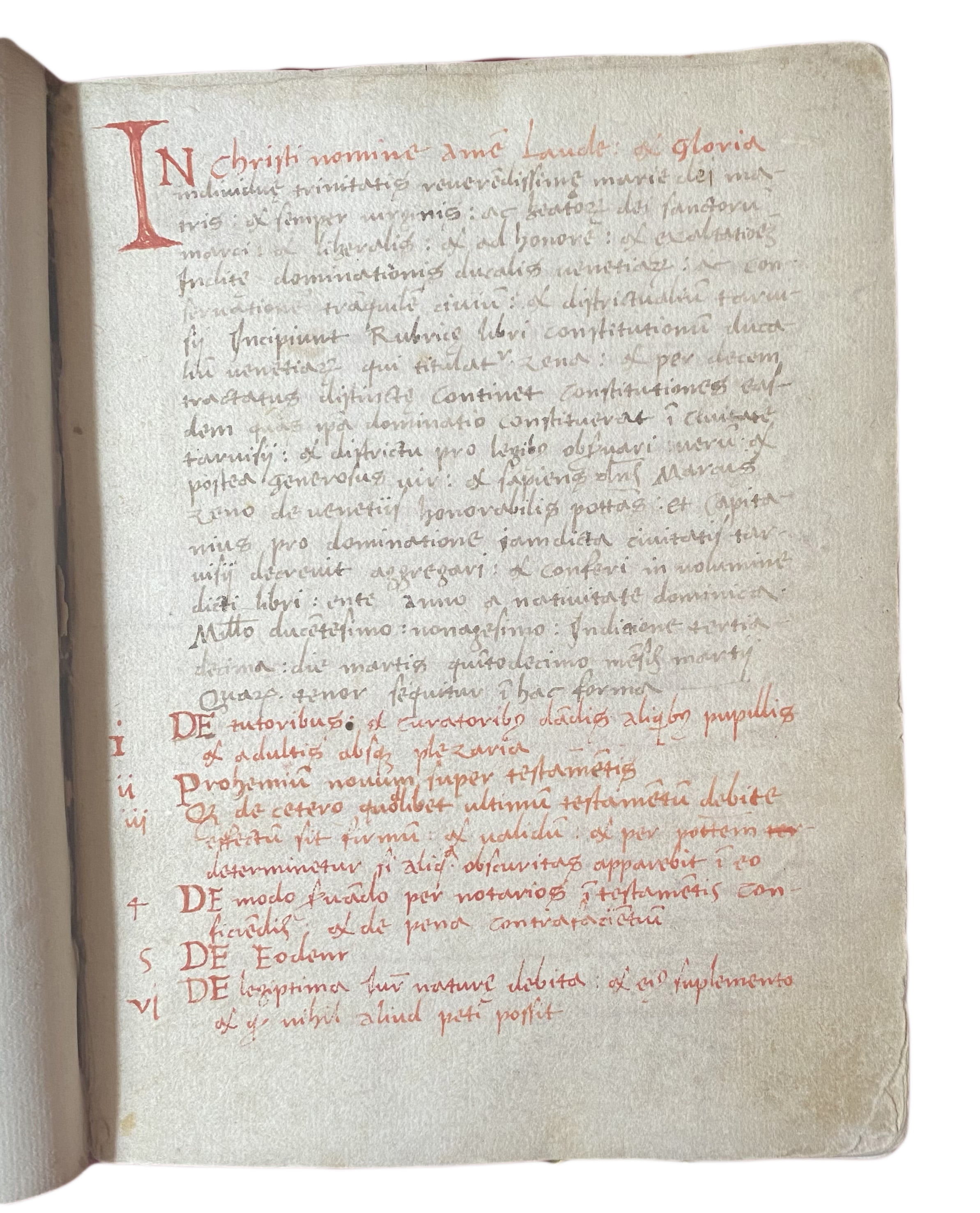ZENO, Marcus.
Digest of the laws of the Venetian Republic and the statutes of the city of Treviso.
North-east Italy, almost certainly Treviso, late fifteenth or early sixteenth century.£36,000.00
Small 4to, 192 by 150mm, 84 leaves (plus 3 endleaves at front, and a single endleaf at back), complete, collation: i-x8, xi4 (these blank), xii4, text in red and black, catchwords and contemporary quire and leaf signatures. Single column, approximately 30 lines per page in a semi-humanist hand, red rubrics and contents list, simple red initials (some in thin, crude red penwork), running titles for a few leaves (faded to light brown). First endleaf with full page coat-of-arms between and beneath sets of initials ‘JM’ and within a wreath with coloured dots perhaps indicating gemstones, this page showing light trimming. Small spots and stains, some text a little faded or washed out at edges, in presentable, legible and solid condition. In sixteenth-century limp parchment with flap, reusing small scraps of an early printed religious work as binding material, repairs to holes and splits, remains of two paper labels on spine, in box.
Decorated manuscript on paper.
Provenance:
Written for the use of Jacobus Menutiis/Minutiis, with his ownership inscriptions three times on the front endleaves and his arms and initials also, clearly produced for his practical use as a lawyer in Treviso and the vicinity. One of these ex libris gives his profession as a notary. Copies of this definitively local text seem to have always been few, and this manuscript was probably made directly from the original compendium held in the regional palatio of Treviso (see below).
Text:
This text announces in its prologue that it was called the ‘Zena’ in Venetian Italian, and contains a compendium of laws and statutes local to the town of Treviso, a small town to the north east of Venice was under the direct rule of the Venetian doges throughout the Renaissance. It was commanded to be assembled by Marcus Zeno “de venetii”, lord of Treviso, in 1390 (the date given here mistakenly ‘1290’), and the Venetian name of the text in fact was taken from the name given to the original manuscript of the compendium kept in the regional palatio of Treviso. That original codex is now lost, but a copy survives in another compendium of the early fifteenth-century copy (probably of c. 1411), now in the archives of the Museo Civico of nearby Asolo (see G. Farronato and G. Netto, Gli Statuti del Comune di Treviso (1316-1390) secondo il codice di Asolo, 1988), and that has been claimed as the earliest recorded manuscript. We have located only two others, both of the sixteenth century: in the library of St. Mark’s in Venice (Cod. 182 chart.: J. Valentinelli, Bibliotheca manuscripta ad S. Marci venetiarum, 1870, p. 124), and the Bodleian (H.O. Coxe, Catologi codicum manuscriptorum, 1854, III, pp. 606-07, his no. 227, dated 1574). The text was published by G. Bettinelli in 1768 (Statuta provisionesque ducales civitis Tarvisii, p. 425-511).
It opens with a short prologue, followed by a copy of a Venetian ducal document issued by Antonius Venerius, the doge of Venice in 1382-1400. The main text is a lengthy and notably thorough legal textbook (fols. 1r-76v), giving a thorough grounding in the civil law of the Venetian Republic, including sections on notaries (public and those of the chancellor), an array of types of wills, sample legal cases and pleas, sentencing, fugitives, petitions, pledges for debts and violent criminal cases such as injury resulting in bloodshed or murder, as well as many others. It opens with a list of all the chapters, in red ink, and then subdivides its material into ten books, covering: 1. The giving of evidence; 2. Civil pleas and cases; 3. Pledges and debts; 4. Appeals; 5. Legal agents; 6. Sales and contracts, as well as the officials of the chancellery; 7. Notaries and their functions; 8. Misleading documents; 9. Criminal cases; 10. Practical statutes for Treviso, describing themselves as diverse ‘acts’. After a single blank gathering, the volume closes with an alphabetised index (in the main hand), here named the Ordo solutionis.
In stock








